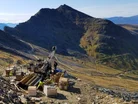Biden Ruling 'Threat to US Critical Minerals Mining'

A proposed US government sustainability ruling that will protect a tenth of the country’s public land threatens the critical minerals mining industry in North America, a leading mining industry body says.
The US government’s recently announced Public Lands Rule (PLR) will help conserve wildlife habitat, restore places impacted by wildfire and drought, expand outdoor recreation, and “guide thoughtful development”.
The new ruling affects the management of an estimated 245 million acres of public property – roughly one-tenth of the US’s land mass. It is part of President Joe Biden's efforts to combat climate change by restricting oil and gas activities on public lands, and to conserve a third of US lands and waters.
While welcomed by conservationists, the government is facing legal challenges from fossil fuel industry groups, some of whom characterise the plan as a “land grab.”
And the Essential Minerals Association (EMA) warns that the PLR will harm the critical minerals industry at a time when certain minerals are needed more than ever in the move to clean energy.
The EMA is the representative voice for companies in North America that extract and process industrial minerals. Its President, Chris Greissing, says of the ruling: “Our nation is in desperate need of the essential mineral resources that EMA members responsibly extract from federal lands, as well as the high-paying jobs they provide and support nationwide.
“Under existing law, BLM has successfully managed federal lands using the multiple use goals laid out in Federal Land Management Policy Act. “However, the rule being proposed represents a clear and imminent threat to the minerals industry and its contributions to the economy, including the green energy transition, which relies heavily on many of the minerals EMA members produce.”
US public land no longer leased to mining companies
Historically, the US Bureau of Land Management (BLM) – known as the nation’s largest landlord – has offered public land leases to oil and gas companies, mining firms and ranchers. Now, the 80-year-old agency is set to auction off so-called ‘restoration leases’ and ‘mitigation leases’ to organisations who plan to restore or conserve public lands.
In Alaska, for example, the new ruling will prevent the building of a planned 340-km road designed to facilitate mine development in the Ambler Mining District in north central Alaska.
Ambler is rich in copper, zinc, lead, gold, and silver deposits, with the metals mined by various methods, including open-pit mining and underground mining.
Copper especially is a major focus of mining activity in the Ambler District due to its abundance and economic value, and there are concerns that the inability to mine it will impact copper supplies in the long term.
As the world continues to shift towards sustainable energy sources the demand for copper – a vital component in electrical systems – will soar. Copper’s role in global electric vehicle (EV) production is particularly key.
But global copper production cannot simply be cranked up to meet soaring demand. New copper mines that came online within the past three years had an average lead time of 23 years from discovery to production.
- Soluna & Canaan: Bitcoin Mining Powered by Renewable EnergyAutomation & AI
- BYD’s Blade Battery: Reducing Reliance on Nickel and CobaltSustainability
- Anglo American and Teck: Forming a Global Minerals GiantSupply Chain & Operations
- Maaden Appoints Donovan Waller to Lead Mining Tech FutureTechnology



